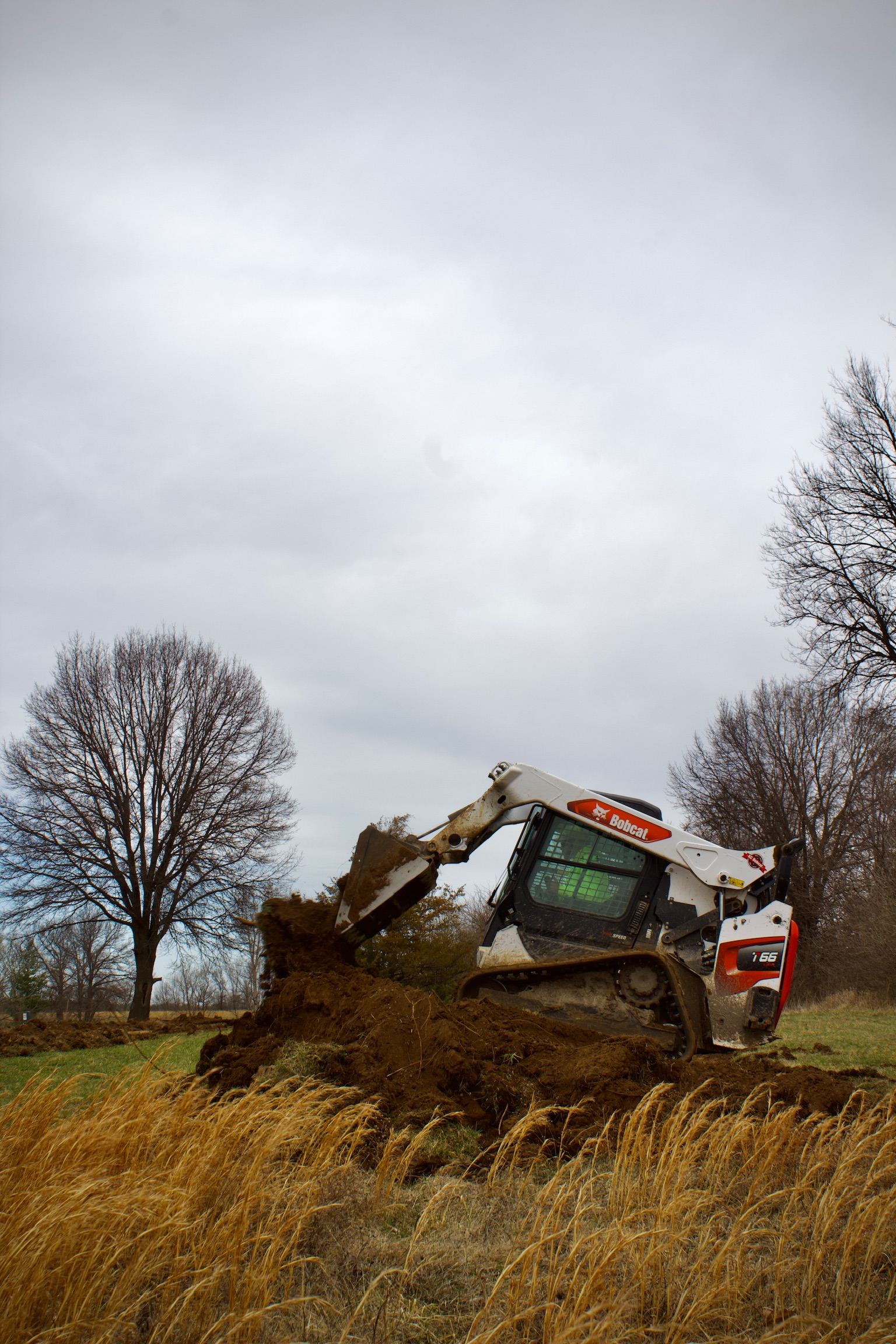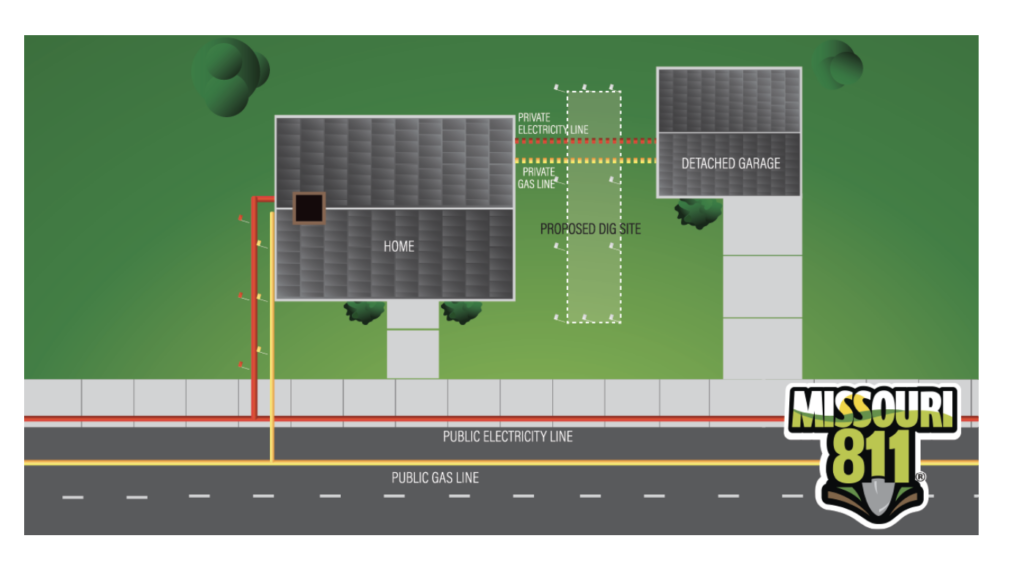
If you’re getting ready to break ground or we’re slated to be working for you soon — whether it’s for a large building pad or a small drain repair — you’re dealing with work that breaks the ground’s surface.
Before that first shovel or bucket breaks ground, it’s important to remember what’s hidden below — critical lines that carry electricity, water, gas, sewer, and internet to your structure, whether it’s residential, commercial, farm, telecom, or industrial.
Striking one of those lines can shut down service, cause expensive damage, or put lives in danger.
Step One: Always Call 811
No matter where the project is located in the United States, calling 811 is the first step before any digging begins for the person doing the digging. If you’re hiring a contractor, it’s their responsibility to make the 811 request. If you’re doing the digging yourself, it’s on you to place the call or online ticket.
(So if we’re slated to be loading up and heading your way soon, we’re taking care of this part — but please keep reading, that’s not all that needs to be done. You have a responsibility too.)
811 is a free, federally designated service that routes your request to your state or regional utility notification center.

Here’s how it works (specifically for Missouri):
1. Submit a Locate Request (done by person or entity doing the digging)
Use missouri-811.org or dial 811. You must make the request at least 3 but no more than 10 working days before you plan to dig. Weekends and state/federal holidays do not count toward the 3-day window.
2. Utilities Are Notified
Missouri 811 contacts all public utility providers near your dig site.
3. Lines Get Marked or Cleared
Each utility either sends a locator to mark their underground lines with paint or flags, or sends an “all clear” notification if there are none in your project area.
4. Confirm the Status
You (or we) confirm all utilities have responded and that the markings match expectations.
5. Dig with Care
Once everything’s confirmed, excavation can begin — with awareness, caution, and proper separation from marked utilities.
The Tolerance Zone
When digging near marked utility lines, remember to follow the tolerance zone. This typically means using hand tools only when feasible within 24 inches on either side of the marked utility line (not including the width of the utility itself). Utilities in this zone should be supported and protected throughout your work to prevent damage or disruption.

When the flags or paint show up, here’s what the colors mean:

- 🔴Red – Electric
- 🟡Yellow – Gas or propane
- 🔵Blue – Water
- 🟢Green – Sewer
- 🟠Orange – Cable or internet
- 🟣Purple or pink – Sometimes used for irrigation or unknown utilities
These markings help whoever is digging — whether it’s us, another contractor, or a client with a shovel — know where to avoid or where to proceed with extreme care.
But 811 Doesn’t Mark Everything
Here’s where it gets tricky:
It’s a common misconception that once the flags (or paint) are down, everything underground has been accounted for. But 811 only marks public utilities — typically up to the meter. Your meter is where the utility provider’s responsibility ends — like the electric meter on a building, or a gas meter mounted near a foundation or property line.
Even utilities you’d normally think of as “public” may include private portions — and those parts won’t be marked by 811.
For example, on commercial or rural sites, it’s common for electrical meters to be mounted on a pole or pedestal separate from the structure. In that case, the line from the meter to the building is private and won’t be flagged by a public utility locate. The same applies to gas, water, or telecom lines that extend from the meter to serve detached buildings, lighting, gates, or specialty infrastructure.
If it runs beyond the utility’s point of responsibility, it’s on the property owner or project manager to identify and protect.

Common Private Utilities That Won’t Get Marked
These are lines we frequently see that won’t be flagged by a public utility locate:
- Water lines from the meter to your structure or outbuildings
- Electric lines from the meter to the main structure, detached buildings, lighting, or signage
- Septic systems and laterals
- Propane lines from tank to structure
- Gas lines to grills, fire pits, or outdoor lighting
- Irrigation systems
- Geothermal loops or supply lines
- Invisible dog fences or gate automation wiring
- Private fiber or coaxial cable lines
What Our Terms & Conditions Say (and Why That Matters)
If we’re working for you, we take utility locating seriously — not only because it’s a safety issue, but because it’s a financial one too. Any contractor working on your site (breaking the surface of the earth) should be having this conversation with you.
That’s why we spell it out in detail in Section 11 of our Terms & Conditions, but as a summary here: Reiss Earthworks will submit public locate requests before digging begins. But when it comes to private utility lines, the responsibility for locating and marking them falls to the client.
That might mean reviewing old site plans or as-builts, connecting with previous contractors or owners, doing some investigative digging, or hiring a private utility locator. If a private line isn’t properly marked and we hit it, it can result in delays, outages, or costly repairs — and those costs fall to the client.
If you haven’t read our full Terms and Conditions, we encourage you to when they are included with your estimate. And if you’re unsure what’s considered public on your project, just ask — we’re happy to collaborate on what’s been marked. Our goal is to avoid surprises — underground or otherwise.
Why It Matters
Hitting a private line can lead to:
- No internet or phone service
- A damaged septic or irrigation system
- A fire hazard or gas emergency
- Project delays, costly liability, or — worst-case — serious injury.
Bottom Line: Don’t Dig Blind — Do the Prep
Digging without clarity on what’s underground is one of the fastest ways to create risk — for your site, your schedule, your contractor, and your wallet. Public lines? They get marked. Private ones? Not by 811.
If something’s unclear, unknown, or the person who installed that electrical 50 years ago is unfortunately no longer with us — let us know! We’d rather talk about it than assume.
Because once digging starts, guessing is not a strategy.
Reiss Earthworks proudly serves Missouri, Kansas, Nebraska, Iowa, Illinois, Tennessee, Kentucky, Arkansas, Oklahoma, and Northeast Texas — primarily supporting the telecom industry when we’re not working in our hometown of the Kansas City metro.
Need a contractor who takes underground risk seriously? Call the best excavator in Kansas City — Reiss Earthworks.
Kudos to the Locators
The men and women who show up to mark these lines deserve more credit than they get. The difference between a correct and incorrect marking can literally be the difference between a smooth project and a life-threatening emergency. These folks are out there in all weather — rain, wind, cold — because 811 tickets don’t stop for the weather. They’re making real-time decisions that keep projects on track and people safe.
This blog is provided for general information only and does not constitute a guide for safe digging practices. Always contact your state’s 811 center directly for project-specific safety guidance and regulations. Some images pulled from Missouri 811’s website.
– Cami Reiss, “Dirt Girl”, CEO & President of Reiss Earthworks
Send me a message through the contact form on my website if you’d like to discuss a project, have an idea for me to write about, have a question (dirt or business-related), or have any feedback.
Note: Our blog posts are written from within the company. Sometimes by one, sometimes by many. Sometimes, they are like a friendship quilt in which everyone puts forth effort. They are not a result of a social media manager typing into artificial intelligence asking for a 900-word blog post, followed with copy and paste and calling it good. If Cami’s writing…. sentences are sometimes long and the thoughts bounce around. If Cali’s at the keyboard, nothing will be spelled correctly for sure. And if Cadi’s typing away, you’ll get “to the point” and probably spelled correctly. Yes, a lot of C names. Needless to say, clients don’t hire us to write for them (not yet, at least. We are interested in technical writing in our industry if anyone’s looking to hire us and provide housing in a warm winter climate- Only half kidding, of course.) Thanks for showing interest. The goal is to meet clients here and assist business owners on the same journey as us if we can.
The information provided in this blog is for general entertainment and informational purposes only. It is not intended to be construed as professional advice or a guarantee of service or result. While I aim to provide accurate and helpful information, any statements, details, or pricing shared are approximate and may change based on specific project details. Reiss Earthworks does not accept liability for any inaccuracies or errors. Always consult directly with us for precise estimates or advice for your specific project.
© Reiss Earthworks LLC, 2025. All rights reserved.
Posted: